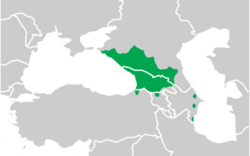Biology:Caucasian smooth newt
| Caucasian smooth newt | |
|---|---|
| Scientific classification | |
| Domain: | Eukaryota |
| Kingdom: | Animalia |
| Phylum: | Chordata |
| Class: | Amphibia |
| Order: | Urodela |
| Family: | Salamandridae |
| Genus: | Lissotriton |
| Species: | L. lantzi
|
| Binomial name | |
| Lissotriton lantzi (Wolterstorff, 1914)[1]
| |

| |
| Synonyms[2] | |
| |
The Caucasian smooth newt or Caucasian newt (Lissotriton lantzi) is a newt species found in the Caucasus region, from the Don river mouth in Russia to Georgia, and potentially Armenia, Azerbaijan and extreme northeastern Turkey.[3][4][5]:235 It occurs from sea level to 2,500 m (8,200 ft) elevation.[4]
Willy Wolterstorff described the species in 1914 as Triton vulgaris subsp. typica forma lantzi, a form of the smooth newt (now Lissotriton vulgaris),[1] and it was later raised to subspecies rank.[2] After genetic data had suggested the smooth newt was a complex of distinct lineages,[6] Dubois and Raffaëlli, in 2009, recognised several subspecies, including the Caucasian smooth newt, as distinct species.[7] This was followed by subsequent authors.[2][3][8]
The species differs from other species in the smooth newt species complex mainly in the male secondary characters during breeding season.[3] The dorsal crest in males reaches 1 mm or more in height and has an almost spine-shaped denticulation. The tail gradually elongates into a fine thread but has no distinct filament. The body is slightly square-shaped but has no dorso-lateral folds. Toe flaps are moderately developed.[5]:235
Paedomorphic adults have been recorded for the Caucasian smooth newt.[9]
The species's conservation status has not yet been evaluated separately from the smooth newt by the IUCN. Since its range is much smaller than that of the smooth newt species complex as a whole, it is likely to be more vulnerable than previously estimated.[3] In Armenia, Azerbaijan and northeastern Turkey, it is potentially extinct. It is listed in the Red Data Books of Russia and the majority of its North Caucasus provinces and autonomous republics. Destruction of aquatic habitats, deforestation, collection for the pet trade and the introduction of fish were cited as threats.[4]
References
- ↑ 1.0 1.1 Wolterstorff, W. (1914). "Zwei neue Tritonformen der paläarktischen Region" (in German). Abhandlungen und Berichte aus dem Museum für Natur- und Heimatkunde zu Magdeburg 2: 371–381.
- ↑ 2.0 2.1 2.2 Frost, D.R. (2020). "Lissotriton lantzi (Wolterstorff, 1914)". Amphibian Species of the World: An Online Reference. Version 6.1 (New York, USA: American Museum of Natural History). doi:10.5531/db.vz.0001. https://amphibiansoftheworld.amnh.org/Amphibia/Caudata/Salamandridae/Pleurodelinae/Lissotriton/Lissotriton-lantzi. Retrieved 25 April 2020.
- ↑ 3.0 3.1 3.2 3.3 Wielstra, B.; Canestrelli, D.; Cvijanović, M. et al. (2018). "The distributions of the six species constituting the smooth newt species complex (Lissotriton vulgaris sensu lato and L. montandoni) – an addition to the New Atlas of Amphibians and Reptiles of Europe". Amphibia-Reptilia 39 (2): 252–259. doi:10.1163/15685381-17000128. https://orbi.uliege.be/bitstream/2268/219665/1/Amphibia-Reptilia_2018.pdf.
- ↑ 4.0 4.1 4.2 Skorinov, D.V.; Doronin, I.V.; Kidov, A.A.; Tuniyev, B.S.; Litvinchuk, S.N. (2014). "Distribution and conservation status of the Caucasian Newt, Lissotriton lantzi (Wolterstorff, 1914)". Russian Journal of Herpetology 21: 251–268. doi:10.30906/1026-2296-2014-21-4-251-268.
- ↑ 5.0 5.1 Sparreboom, M. (2014). Salamanders of the Old World: The Salamanders of Europe, Asia and Northern Africa. Zeist, The Netherlands: KNNV Publishing. doi:10.1163/9789004285620. ISBN 9789004285620.
- ↑ Babik, W.; Branicki, W.; Crnobrnja-Isailovic, J. et al. (2005). "Phylogeography of two European newt species – discordance between mtDNA and morphology". Molecular Ecology 14 (8): 2475–2491. doi:10.1111/j.1365-294X.2005.02605.x. ISSN 0962-1083. PMID 15969729.
- ↑ Dubois, A.; Raffaëlli, J. (2017). "A new ergotaxonomy of the family Salamandridae Goldfuss, 1820 (Amphibia, Urodela)". Alytes 26: 1–85.
- ↑ Pabijan, M.; Zieliński, P.; Dudek, K.; Stuglik, M.; Babik, W. (2017). "Isolation and gene flow in a speciation continuum in newts". Molecular Phylogenetics and Evolution 116: 1–12. doi:10.1016/j.ympev.2017.08.003. ISSN 1055-7903. PMID 28797693.
- ↑ Skorinov, D.V.; Novikov, O.; Borkin, L.J.; Litvinchuk, S.N. (2009). "Two new cases of paedomorphopsis in the Caucasian newts: Ommatotriton ophryticus (the first record) and Lissotriton vulgaris lantzi". Russian Journal of Herpetology 16: 16–18.
Wikidata ☰ Q3242643 entry
 |

